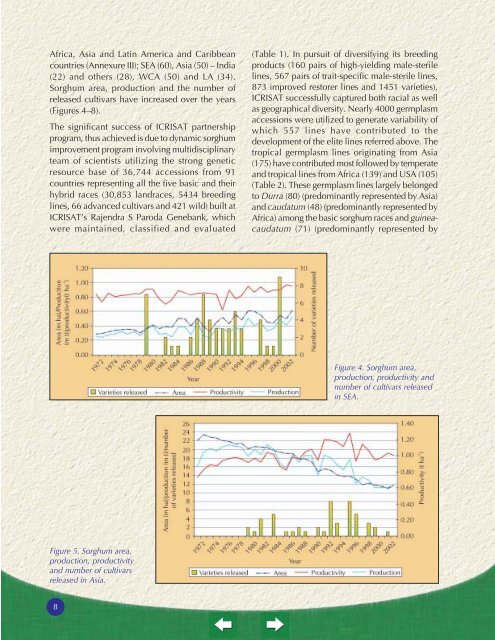Sorghum - icrisat
Sorghum - icrisat
Sorghum - icrisat
Create successful ePaper yourself
Turn your PDF publications into a flip-book with our unique Google optimized e-Paper software.
Africa, Asia and Latin America and Caribbean<br />
countries (Annexure III); SEA (60), Asia (50) – India<br />
(22) and others (28), WCA (50) and LA (34).<br />
<strong>Sorghum</strong> area, production and the number of<br />
released cultivars have increased over the years<br />
(Figures 4–8).<br />
The significant success of ICRISAT partnership<br />
program, thus achieved is due to dynamic sorghum<br />
improvement program involving multidisciplinary<br />
team of scientists utilizing the strong genetic<br />
resource base of 36,744 accessions from 91<br />
countries representing all the five basic and their<br />
hybrid races (30,853 landraces, 5434 breeding<br />
lines, 66 advanced cultivars and 421 wild) built at<br />
ICRISAT’s Rajendra S Paroda Genebank, which<br />
were maintained, classified and evaluated<br />
(Table 1). In pursuit of diversifying its breeding<br />
products (160 pairs of high-yielding male-sterile<br />
lines, 567 pairs of trait-specific male-sterile lines,<br />
873 improved restorer lines and 1451 varieties),<br />
ICRISAT successfully captured both racial as well<br />
as geographical diversity. Nearly 4000 germplasm<br />
accessions were utilized to generate variability of<br />
which 557 lines have contributed to the<br />
development of the elite lines referred above. The<br />
tropical germplasm lines originating from Asia<br />
(175) have contributed most followed by temperate<br />
and tropical lines from Africa (139) and USA (105)<br />
(Table 2). These germplasm lines largely belonged<br />
to Durra (80) (predominantly represented by Asia)<br />
and caudatum (48) (predominantly represented by<br />
Africa) among the basic sorghum races and guineacaudatum<br />
(71) (predominantly represented by<br />
Figure 4. <strong>Sorghum</strong> area,<br />
production, productivity and<br />
number of cultivars released<br />
in SEA.<br />
Figure 5. <strong>Sorghum</strong> area,<br />
production, productivity<br />
and number of cultivars<br />
released in Asia.<br />
8
















